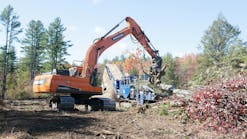California has a zero waste goal by 2030 with a 75% diversion by 2020. In California, construction demolition makes up almost 30% of the landfill. “To get zero waste, they have to take a better look at C&D,” says Richard Ludt. He works for Interior Removal Specialist (IRS Demo) in South Gate, CA, the only interior demolition contractor in the country that runs its own C&D recycling operation (Construction and Demolition Recycling ([CDR]) to satisfy LEED and green building requirements. The operation—which has 250 employees and a 14-acre permitted recycling facility—received SWANA’s bronze honor in the 2016 special wastes management category. “Our corporate mentality is, we look out for the best interests of the building and to that end, we became certified e-waste collectors and certified appliance recyclers,” says Ludt. Some of the materials IRS Demo recovers in its operations are sent to Waste-to-Energy facilities.
What He Does Day to Day
In his role as IRS Demo’s director of environmental affairs and LEED AP, Ludt spends his days dealing with permitting issues and overseeing regulatory compliance. He also tends to his duties as SWANA’s corporate director for recycling and material recovery.
What Led Him to This Line of Work
“I literally fell into it,” notes Ludt. He had been a key grip in the film industry until work started to drop off in 2001. Carlos Herrera, president of IRS Demo, wanted help putting together a corporate web page and video, so Ludt helped out part-time. The two hit it off. Herrera kept offering Ludt a job. “I told him I was a movie guy and far too important for that, but thank you. Film work is going to pick up,” says Ludt. One day, Ludt injured his foot while doing rigging on a music video. “I came back two weeks later with a cast up to my hip and asked Carlos if we could talk about that full-time gig he offered me,” says Ludt. Herrera hired Ludt, who immersed himself in learning about California’s recycling sector.
What He Likes Best About the Work
Ludt derives a great sense of satisfaction from the fact that his company donates 30 to 60 tons of C&D waste monthly to nonprofit organizations. Because IRS Demo deals in high-end commercial interior office demolition, much of the material is in mint condition. The remaining material is directed to its state-certified C&D recycling operation, which has an 80.89% diversion rate and is certified by the Recycling Certification Institute (RCI). Ludt aggregated data on the RCI website and found 41% of the inbound debris at most C&D facilities is dimensional lumber and 31% of inbound material is inert, such as concrete, asphalt, and rock. “Those are very easily recycled materials,” he points out. “Standard facilities are looking at 72% diversion on two commodities that never come into a commercial interior demo project. We’re basically recycling 80% of the 20% they’re throwing away. There isn’t much money in drywall, carpet, and manufactured lumber—the big items that come out of commercial interior work—so nobody wants to pull it out of the waste stream. It’s also the most toxic aspect of C&D. All of the chemicals in manufactured lumber are nasty. Four pounds of drywall in a landfill—which is an anaerobic environment—will create one pound of hydrogen sulfide gas and eventually eat holes in the methane collection system.”
Trying to make everyone work to the same standards as his company is his greatest challenge, notes Ludt. “Anybody with 10 guys, a pickup truck, and a contractor’s license is our competition,” he says. “Commercial interior high-rise demolition is very much a specialty trade. Our guys need to know low-voltage data lines, HVAC, plumbing, and electrical—they need to know enough where we don’t end up in trouble in the building because they got the wrong stuff. That makes us more expensive than our competition.” Informing clients of the environmental damage that can be caused by some C&D materials and then being mishandled is another challenge, Lutz adds. “The stuff that does the most damage is the stuff we’re actually keeping out of the landfill,” says Ludt.











